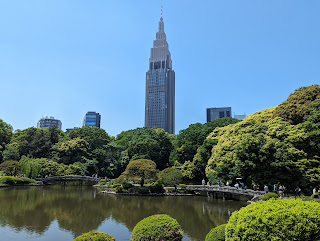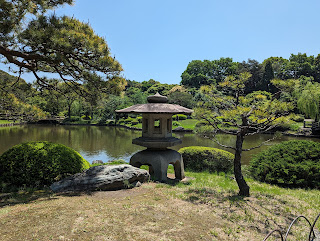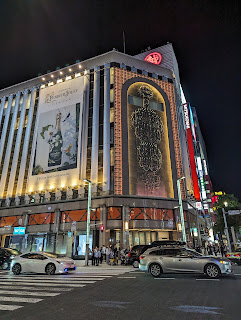It wasn't uncommon to see young male rickshaw drivers in the busy streets around Asakusa, the area of Tokyo where we stayed. I wondered how bumpy a ride it might be and the wear and tear the toll must be on the driver's body. There can't be any longevity in that profession!
Considering how the Japanese are so well known for their formal manners, it was surprising to notice how seemingly able-bodied people, often young people, would immediately sit in the clearly marked Priority Seats on the metros even when regular seats were untaken. To go a step further, those seats were rarely offered to people for whom they were meant.
In 2013, on our first overseas trip together, Steven and I met an Irishwoman, Val, in a hostel in Mongolia's capital city of Ulan Bataar and jointly arranged a three-day trip to "the back of beyond" with a guide provided by the hostel. The three of us had the time of our lives riding camels (and have the scars to prove it thanks to a drunken camel herder!), some food poisoning in a freezing yurt, and driving across just plowed fields hitting our heads on the roof of the van with every bump. Even with those mishaps, we've never laughed so much in our lives before or since as Val regaled us with stories of her siblings, growing up in both Canada and Ireland, her many loves, and her life as a well-known writer of fable stories for young adults using her pen name of O.R. Melling. We kept in touch over the years and managed to reconnect in person once since. Luckily, our paths crossed again on this, our last day and Val's first day in Tokyo, as she was on an extended speaking tour to promote her books courtesy of the Irish and Canadian governments.
We thought it would be so easy to meet her at 10 at the entrance to Shinjuku Gyoen National Garden, originally the private estate of a feudal lord and then an agricultural experiment during the Meiji era of 1866-1912. In 1909, it was made into a garden for the Imperial Family before being opened to the public in 1949 as a national garden. The garden should only have been a 10-minute walk from any one of several metro stations but Val got hopelessly lost so our meet-up time and location in the garden kept changing. Thanks to WhatsApp, the best app ever for travelers, we got constant updates on where she was but didn't see hide or hair of her until two hours later!
In the meantime, we saw an enormous oak and a ...
grove of various cedar trees planted in the garden during the Meiji period. The Deodar Cedar took pride of place in the Woodland Garden.
Since the Dawn Redwood was discovered in China in 1946, it has also been planted in Japan. It's considered a "living fossil" because a fossil of the species was actually found before the living tree.
The backdrop to the Japanese Traditional Garden was the NTT Docomo Yoyogi building. When we travel, Steven and I are always suckers when it comes to formal Japanese gardens so, once we knew it was going to be a while before Val appeared, we hightailed it to that section of the immense Shinjuku.
I don't have Val's way with words to describe how exquisite the Japanese garden was so I hope the photos will help convey its beauty.
We've planned a couple of trips to Taiwan but Covid and my leg issues have gotten in the way so far. That country's beautiful Kyu-Goryu-Tei Pavilion would have to make do for now. We're hoping to reschedule the trip for early next year as long as the next surgery on my leg goes off without a hitch the day after we get home and China doesn't invade the island. Keep your fingers crossed on both accounts, please!
This unusual tree was called Maidenhair although most people might know its other name Ginko Bilboa.
Steven and I had been at the world's busiest Starbucks location the previous day - this had to be its most beautiful!
Diana: More Japanese red maples for you!
The Kids' Area would have been a lovely place to relax but it was only for people with children under 13.
The bad news was we were about three weeks too late for Japan's celebrated Cherry Blossom Season when it's an absolute madhouse all over the country. The good news was that we could relish the Cherry Tree Area with hardly a soul in sight.
With still no sight of Val, Shinjuku's Formal Garden was our final destination. For rose lovers, this was the place to be! The only other rose garden where we've been treated to such a gorgeous array of roses was the Rose Garden in Portland, Oregon.
The Ingrid Bergman roses had a heavenly scent - most other varieties had only a faint perfume.
Who could forget their childhood exposure to Shakespeare when seeing the Romeo rose?!
The variegated pinkish hues reminded me of the variegated yarns I use for knitting!
The impressive Avenue of London Planes bordered the Formal Garden.
Joy - at long last, I found shade-loving Val munching a hot dog under a tree and we picked up right where we left off from years ago! She really wanted to see the Japanese garden so we happily returned there.
Then the Mongol Three as Val describes us, were off to the Meiji Shrine, Tokyo's most venerable Shinto shrine. Shinto, referred to as Japan's original religion, has no founder and no holy book. It values harmony with nature and is deeply rooted in the way of Japanese life.
The shrine opened in 1920 in honor of Emperor Meiji and Empress Shokun. The shrine was destroyed during the war but was rebuilt shortly thereafter. Emperor Meiji, the first emperor of modern Japan, ascended to the throne in 1867 when Japan's feudal era came to an end and the emperor was restored to power. He was critical in opening up Japan to the outside world and joining the world's major powers by the time he passed away in 1912. The shrine is one of Japan's most popular shrines and regularly welcomes more than three million visitors for the first prayers of the New Year, more than any other shrine or temple in the country.
We entered the grounds via the massive torii gate, a shrine's traditional entry gate, which was built of cypress more than 1,700 years old before passing through a tranquil forest consisting of about 100,000 trees donated from throughout Japan and planted during the shrine's construction.
The shaded path, lined with trees and dense woods, was an incredible sanctuary in the middle of hectic Tokyo.
Before entering the main sanctuary, Shinto followers purified themselves by washing their hands, pouring water into both hands, rinsing their mouths, and washing their hands again.
Val insisted she take our photo under the pair of camphor trees planted in 1920 and known as Meoto Kusu or Husband and Wife because the coupled trees were "a symbol of a happy marriage and harmonious life within the family. May happiness be brought to you through the divine power of these trees."
The refined Shinto shrine was constructed of Japanese cypress topped with green copper roofs.
It was a long trek out to the shrine and then back to the city to the area around Shinjuku, the busiest train station in the world, but Steven and I were hoping to make it to Omoide Yokocho aka Piss Alley before the day was done.
I'll eat my previous words here when I spoke disparagingly about Tokyo's architecture as these buildings made up for so many boring ones we'd seen!
Earlier, at the National Garden, Val had given me a hard time about trying to squeeze too much into our day and we should just go with the flow, etc, etc. That was all well and good until she realized the narrow street filled with tiny bars and barbecue stands looked exactly like one of her favorite Japanese TV shows and then she was the happiest woman in Tokyo we'd dragged her there!
The tiny alley of around 60 extremely small bars and restaurants was just wide enough for two to pass side by side, in stark contrast to the more modern and mobbed streets nearby. Omoide Yokocho or Memory Lane started out as a black market in the late 1940s after World War II and was also known for cheap drinks and grilled skewers of grilled chicken or yakitori. Its many watering holes and lack of public bathrooms earned it the nickname “Piss Alley,” as inebriated patrons relieved themselves in the street.
Yakitori and nikomi, a type of beef tendon stew, were among the many offerings meant to be washed down with plenty of cheap beer and sake.
We all had a hoot eating in an 8-stool hole-in-the-wall place Val chose but the prices were anything but divey. The finger foods cost an arm and a leg but they were delicious and the experience was worth its weight in gold! Phew - I was glad I had done my research for the trip and knew how much fun Piss Alley would be as Val sure had to eat her words!
With more laughs and hugs, we bid adieu to Val and hoped the Mongol Three would meet up again in another corner of the world before too long!
You should know us by now and that, nope, the day wasn't done yet! It was back to glitzy Ginza to discover whether seeing it in the early evening might make the oh-so-grand shopping mecca more attractive than it had in the rain a few days earlier.
It turned out our first impressions were true for us except it was a lark being able to walk along the main drag that had been turned into a car-free zone for a while.
Steven and I obviously didn't do adequate research when it came to buying tickets for the show that night. We thought the one-act play would involve swashbuckling sword fights, music and dancing, masked characters popping in via trap doors, and changing sets. However, what we ended up seeing from the nosebleed seats was a sewamonto play that portrayed the lives of ordinary people in the Edo Period. The play caused a sensation in its day because it was unerringly realistic. It was not to our taste and it didn't help that we didn't understand a word of Japanese and had stupidly not gotten an English audio beforehand.
Ginza's bright lights were what the area needed!
Posted on May 11th, 2024, after another fun but very long day in Kyoto. After the initial meh days in Tokyo, our appreciation of the city improved drastically thanks to its dreamy gardens, the gorgeous irises at the Nezu Museum, the madness of the Shibuya Scramble, some fun retail therapy, and the amusing Golden Flame. Steven deserves huge kudos as he made getting around the huge metropolis appear very easy after spending hours poring over maps online back home!
Next post: Onto Hakone, a city we'd never heard of before researching this trip, and what a find it was!































































Keep a running tally of your steps….you will have done the equivalent of circumnavigating the world by the time you return! It’s beautiful and you’ve done a wonderful job with your photos.
ReplyDeleteHappy and healthy travels.
I don't know whom to acknowledge/thank with no name but good thought about keeping a running tally of my steps. My pedometer app only goes back one week but we're regularly walking 8 or so miles a day and often far more than that. Pretty good for two old people using a cane and a pair of sticks to get around. Hope this exercise will help me get back in shape more quickly after the next surgery in June! Thanks for the compliment about the photos - I appreciate it.
DeleteDear Annie : Oh how I loved to see photos of Val as you reunited as the Mongul three; her smile and joie de vivre transcended the pages of your post. And the flowers in the gardens were exquisite .. I tried to imagine the heavenly perfume scent of the Ingrid Bergman roses. Happy travels . xo xo Lina ox xo
ReplyDeleteWould that I could convey the intoxicating scent of the Bergman rose, Lina! SO much fun reconnecting with Val in Tokyo and already hoping it's not too long before we meet up again. XOXO right back at you!
DeleteAnnie, I was interested that most of the roses didn’t have a wonderful scent.
ReplyDeleteI do so enjoy your pictures and commentary!💗Tess
Ahh, thanks Tess! For me, much of a rose's beauty is its scent and to have that missing from all but two whose scent I inhaled was disappointing.
ReplyDeleteMy father had a Dawn Redwood tree at our house in St Louis. I wonder how big it is now, 50 years later. The garden photos are all lovely. They remind me the ones in St Louis and Denver Botanic gardens. Janina
ReplyDeleteGlad the photos brought back such good memories of your home in St. Louis, Janina! Perhaps you and Pat should stop your old stomping ground one day and ask to see the redwood.
ReplyDelete